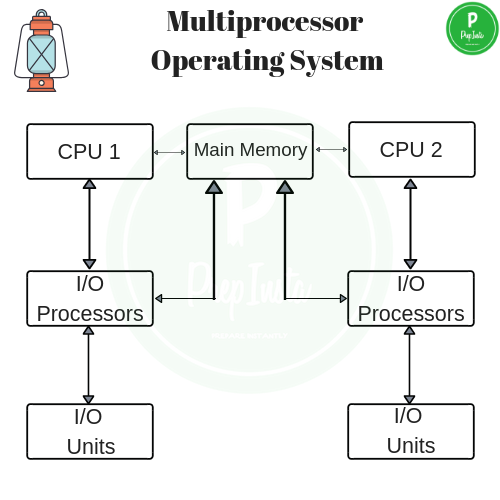Explain Different Types of Multiprocessor Operating Systems
Applications of Multiprocessor. Symmetric and asymmetric multiprocessors.

Multiprocessor Operating Systems In Os Prep Insta
But there are some extra features available in multiprocessor operating systems those extra features are listed below.

. Uniform memory-access UMA system NUMA system Uniform memory access UMA system Heterogeneous multiprocessing system. In this types of the organization then there are much Central processing units in the system and each CPU has its own private operating system and memory is shared among all the processors and input-output system are also shared. Batch Operating System This type of operating system does not interact with the computer directly.
Types of multiprocessing systems Symmetrical multiprocessing operating system Asymmetric multiprocessing operating system. An operating system protects your data from cyberattacks. Master processor assigns ready state processes to the slave processors.
If you dont know what Operating system is you can learn from here. There are various organizations of multiprocessor operating system. Shared memory Multiprocessor As the name indicates each.
There is an operator which takes similar jobs having the same requirement and group them into batches. When a system call is made the CPU on which the system call was made traps to the kernel and processes the system call. Shared Memory Cluster All of.
Advantages of Batch Operating System. A symmetric multiprocessing system is a system with centralized shared memory called main memory MM operating under a single operating system with two or more homogeneous processors. These types of systems are used when very high speed is required to.
There is one copy of the operating system in memory but any CPU can run it. It is the responsibility of the operator to sort jobs with similar needs. There are two types of systems.
Shared disks MP The advantages of shared disks are that part of a familiar programming model is retained disk data is. In shared memory multiprocessors all the CPUs shares the common memory but in a distributed memory multiprocessor every CPU has its own private memory. These multiple CPUs are in a close communication sharing the computer bus memory and other peripheral devices.
Symmetrical Multiprocessing Operating Systems Asymmetrical Multiprocessing Operating Systems Advantages of Multiprocessor Operating System OS Due to the multiprocessing system processing tasks can be distributed among. However a multiprocessor machine would be faster if you have numerous apps running. Systems that treat all CPUs equally are called symmetric multiprocessing SMP systems.
A multicore system would be more efficient if you only need to run one program. Here We will explain different types of multiprocessor operating system and classification of its list is done into six types. As a uniprocessor such as single instruction single data SISD Inside a single system for executing multiple individual series of instructions in multiple perspectives such as multiple instruction multiple data MIMD.
In systems where all CPUs are not equal system resources may be divided in a number of ways including asymmetric multiprocessing ASMP non-uniform memory access NUMA multiprocessing and clustered multiprocessing. An operating system manages the startup of a device. Fields Asymmetric Multiprocessor Every processor is given seeded tasks in this operating system and the master processor has.
Following are some of the most widely used types of Operating system. Simple Batch System Multiprogramming Batch System Multiprocessor System Desktop System Distributed Operating System Clustered System Realtime Operating System Handheld System Simple Batch Systems. There are two types of multiprocessors one is called shared memory multiprocessor and another is distributed memory multiprocessor.
An operating system coordinates computer applications and allocates space to different programs installed in the computer. Multiprocessor Operating System Types of multiprocessor operating system There are two main types of multiprocessor OS 1 Asymmetric multiprocessing system In this type of system one processor behaves as a master and the other processors behave as slaves. Symmetric Multiprocessor Asymmetric Multiprocessor Shared Memory Multiprocessor Distributed Memory Multiprocessor UMA Multiprocessor NUMA Multiprocessor Symmetric Multiprocessor.
Different ways of using a multiprocessor include. Depending upon the control structure and its organisation the three basic types of multiprocessor operating system are. These systems are referred as tightly coupled systems.
Each CPU has its own OS. Symmetric multiprocessing SMP Asymmetric multiprocessing ASMP Symmetric Vs Asymmetric Multiprocessing Symmetric multiprocessing systems are those that treat all CPUs equally. There are mainly two types of multiprocessor systems.
Symmetric Multiprocessor In this system every processor owns a similar copy of the OS and they can make. Types of Multiprocessor Operating Systems Following are the two types of multiprocess operating systems used. There are mainly two types of multiprocessors ie.
Multiprocessor operating system OS is almost a regular OS as they also handle system calls do memory management provide file system and also manage inputoutput devices. Our third model the SMP Symmetric MultiProcessor eliminates this asymmetry. Multiprocessor Operating System refers to the use of two or more central processing units within a single computer system.
Handheld Computer Operating Systems Before phones became smarter there was a handheld system commonly referred to as Personal Digital Assistant PDA. These were popular with people in business. The terms multicore and multiprocessor differ in which multicore system refers to a single CPU with several execution units while multiprocessor refers to a system with multiple CPUs.
1 Separate supervisor 2 Master-slave 3 Symmetric Supervision Separate Supervisors In separate supervisor system each process behaves independently. Types of multiprocessing Shared nothing MP The processors share nothing each has its own memory caches and disks but they are interconnected. Details about them are as follows Symmetric Multiprocessors In these types of systems each processor contains a similar copy of the operating system and they all communicate with each other.
Palm OS was the universal standard for PDAs. The three popular Operating Systems for personal computers are Windows macOS and Linux.
Multiprocessing Operating Systems Os Fields Of Study Abstract Principal Terms

Multiprocessing Operating System Javatpoint

Multiprocessor Operating System Types Advantages And Limitations

Multiprocessor Systems What Is Multiprocessor Systems In Os In Hindi Youtube
Comments
Post a Comment